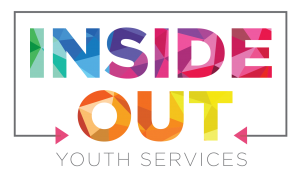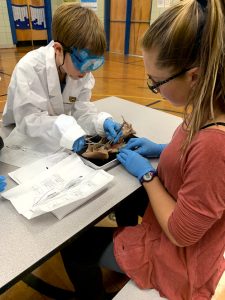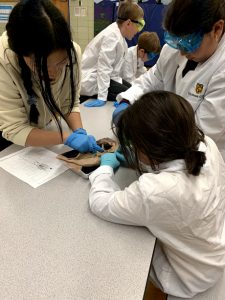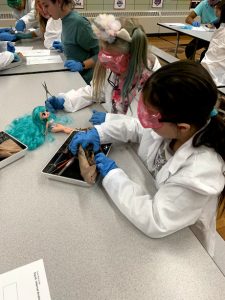Recent findings by the Human Rights Campaign show that only 26% of LGBTQ+ youth report always feeling safe in the classroom. 70% have been bullied for their sexual orientation. 11% have been sexually attacked or raped because of their sexual orientation. One in three LGBTQ+ adults experience mental illness. They are twice as likely as heterosexual adults to have an alcohol or drug use disorder. LGBTQ+ youth are four times more likely to attempt suicide than heterosexual youth. These and more stats can be found at the links at the bottom of this article.
In a culture that can be uncaring, if not outright hostile, Inside Out is an organization dedicated to helping LGBTQ+ youth. Their main focus is providing a safe place to be for local LGBTQ+ youth age 13 to 22. A place to make friends, do work, and never worry about judgment. A place to be yourself. Four days a week, after school, they welcome youth into their space, creating a community of acceptance and togetherness. The organization will be 30 years old next year and is the only drop-in LGBTQ+ youth center in Colorado Springs.
Located in downtown Colorado Springs, Inside Out aims to empower, educate, and advocate for LGBTQ+ youth from southern Colorado. Their education work includes peer support groups, education for youth and parents about transgender experience, education about healthy relationships, and more. They work to educate outside of their own youth community: they teach ‘LGBTQ+ 101’ and ‘Trusted Adults’ classes (pronouns, how to build trust, how to have hard conversations) to parents, teachers, therapists, the Colorado Springs Police Department, and more. Their advocacy work tries to build a better community for LGBTQ+ youth. One current project works with schools to learn about and develop spaces in the school where youth feel safe.
Inside Out Youth Services is also one of the CCE’s High Impact Partners, part of an initiative to develop deep, multifaceted, mutually-beneficial relationships between CC and the Colorado Springs Community. Several Public Interest Fellows and Community Engaged Fellows from CC have worked with Inside Out. Most recently, a sociology class collaborated with Inside Out to perform research and data analysis.
 The Inside Out staff have deep ties back to Colorado College: both the Executive Director and Youth Program Manager are CC graduates. The Development Director was a curator at the Fine Arts Center, and two CC students work as Peer Program Assistants right now. Angelina Chen ’22, a CC sophomore and Community Engaged Fellow from Guangzhou, China, is one of those students. In her first year at CC she explored several local nonprofits in the Colorado Springs area. Inside Out struck her as being a remarkably connected organization. Angelina has worked behind-the-scenes helping with their advocacy to government work, and this year began working with youth, teaching them how to be active community members. She says working with the youth energizes her, she’s always impressed by their social awareness and the level of discourse they’re able to have.
The Inside Out staff have deep ties back to Colorado College: both the Executive Director and Youth Program Manager are CC graduates. The Development Director was a curator at the Fine Arts Center, and two CC students work as Peer Program Assistants right now. Angelina Chen ’22, a CC sophomore and Community Engaged Fellow from Guangzhou, China, is one of those students. In her first year at CC she explored several local nonprofits in the Colorado Springs area. Inside Out struck her as being a remarkably connected organization. Angelina has worked behind-the-scenes helping with their advocacy to government work, and this year began working with youth, teaching them how to be active community members. She says working with the youth energizes her, she’s always impressed by their social awareness and the level of discourse they’re able to have.
Inside Out is looking to expand the opportunities volunteers from CC have to help the organization. They always need volunteers for behind-the-scenes work like communication and events like the Queer Prom they organize every year. Help with advocacy in government is also a potential goal. For more information or to discuss a partnership, contact the CCE, or the Youth Program Manager Candace Woods ’13 at info@insideoutys.org.
Specifically to the LGBTQ+ students at Colorado College, Inside Out wants you to know that you are welcome. This is not an opportunity restricted to some other group, this is a place for you. Learn more at insideoutys.org. Marve Aguinaga ’21 from Escondido, California, is a second CC student working at Inside Out this year. When describing why the work was important, they said, “There are a lot of challenges that come with being queer in this country, and there are certainly challenges here in the Springs, but it can be easier when there are people that can share some of your burden with you.”
Thank you to Candace Woods ’13, Marve Aguinaga ’21, and Angelina Chen ’22 for their help with this story.
– Eric Ingram
Sources:
(1) https://www.hrc.org/resources/2018-lgbtq-youth-report
(2) https://suicidepreventionlifeline.org/wp-content/uploads/2017/07/LGBTQ_MentalHealth_OnePager.pdf




